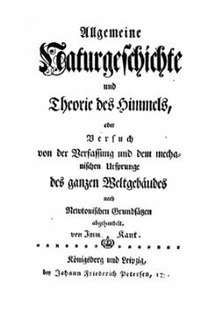Universal Natural History and Theory of the Heavens
 | |
| Author | Immanuel Kant |
|---|---|
| Original title | Allgemeine Naturgeschichte und Theorie des Himmels |
| Country | Germany |
| Language | German |
| Subject | cosmogony |
| Published | 1755 |
| Media type | |
Universal Natural History and Theory of the Heavens (German: Allgemeine Naturgeschichte und Theorie des Himmels), subtitled or an Attempt to Account for the Constitutional and Mechanical Origin of the Universe upon Newtonian Principles,[a] is a work written and published anonymously by Immanuel Kant in 1755.
According to Kant, the
Background
Kant had read a 1751 review of Thomas Wright's An Original Theory or New Hypothesis of the Universe (1750), and he credited this with inspiring him in writing the Universal Natural History.[1]
Kant answered to the call of the Berlin Academy Prize in 1754[2] with the argument that the Moon's gravity would eventually cause its tidal locking to coincide with the Earth's rotation. The next year, he expanded this reasoning to the formation and evolution of the Solar System in the Universal Natural History.[3]
Within the work Kant quotes
Contents
Kant proposes the nebular hypothesis, in which solar systems are the result of nebulae (interstellar clouds of dust) coalescing into accretion disks and then forming suns and their planets.[4] He also discusses comets, and postulates that the Milky Way is only one of many galaxies.[1]
In a speculative proposal, Kant argues that the Earth could have once had a ring around it like the rings of Saturn. He correctly theorizes that the latter are made up of individual particles, likely made of ice.[1] He cites the hypothetical ring as a possible explanation for "the water upon the firmament" described in the Genesis creation narrative as well as a source of water for its flood narrative.[1]
Kant's book ends with an almost mystical expression of appreciation for nature: "In the universal silence of nature and in the calm of the senses the immortal spirit's hidden faculty of knowledge speaks an ineffable language and gives [us] undeveloped concepts, which are indeed felt, but do not let themselves be described."[5]
Translations
The first English translation of the work was done by the Scottish theologian William Hastie, in 1900.[6] Other English translations include those by Stanley Jaki and Ian Johnston.[7]
Criticism
In his introduction to the English translation of Kant's book, Stanley Jaki criticises Kant for being a poor mathematician and downplays the relevance of his contribution to science. However, Stephen Palmquist argued that Jaki's criticisms are biased and "[a]ll he has shown ... is that the Allgemeine Naturgeschichte does not meet the rigorous standards of the twentieth-century historian of science."[8]
References
Footnotes
Citations
- ^ ISBN 978-0-3078-0105-0.
- ^ Manfred Kühn, Kant - A Biography, CUP, 2002), p. 98: "[The essay] entitled "Investigation of the Question whether the Earth Has Experienced a Change in Its Rotation" [...] was meant to answer a question formulated for a public competition by the Berlin Academy. Though the deadline was at first 1754, the Academy extended it on 6 June 1754, for another two years. When Kant decided to publish this essay, he did not know of the extension. Kant claimed that he could not have achieved the kind of perfection required for winning the prize because he restricted himself to the "physical aspect" of the question."
- ISBN 978-0521441711.
- Bibcode:1993QJRAS..34....1W.
- ^ Immanuel Kant, Universal Natural History and Theory of the Heavens, p.367; translated by Stephen Palmquist in Kant's Critical Religion (Aldershot: Ashgate, 2000), p.320.
- ISBN 978-0-486-40675-6.
- ISBN 978-0-521-36394-5.
- ^ Stephen Palmquist, "Kant's Cosmogony Re-Evaluated", Studies in History and Philosophy of Science 18:3 (September 1987), pp.255–269.
External links
- "Online version of the text". Vancouver Island University (in German).
- "English translation". Vancouver Island University.
